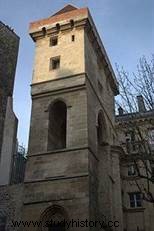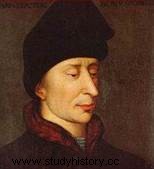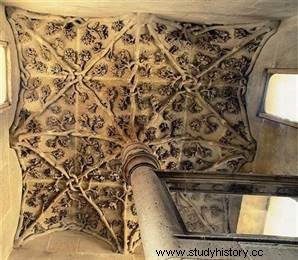 In the heart of Paris, rue Etienne Marcel, stands one of the last still visible vestiges of medieval Paris , the Jean sans Peu tower r. An ostentatious mark of the Burgundian presence in the troubled Paris of the early 15th century, it is a must for anyone passionate about medieval history. It was built by the Duke of Burgundy Jean sans Peur (1371-1419), leader of the party of the Burgundians during the Hundred Years War.
In the heart of Paris, rue Etienne Marcel, stands one of the last still visible vestiges of medieval Paris , the Jean sans Peu tower r. An ostentatious mark of the Burgundian presence in the troubled Paris of the early 15th century, it is a must for anyone passionate about medieval history. It was built by the Duke of Burgundy Jean sans Peur (1371-1419), leader of the party of the Burgundians during the Hundred Years War.
The kingdom of France and the appetite of the dukes
The context is hectic to say the least, so we have to come back to it. On the death of Charles V in 1380, his son Charles VI succeeded him. His father was nicknamed "the Wise", but Charles VI will show signs of weakness caused by fits of madness. He is young at the beginning of his reign, and cannot do much against the rivalries which are increasing within the great families of France, in a France shaken by numerous revolts. The regency is entrusted to Louis I of Anjou, but he quickly becomes greedy and claims custody of the dauphin and his brother, the future Louis of Orléans, which provokes the anger of Jean de Berry and Philippe le Hardi, Duke of Burgundy. The Duke of Anjou then had to withdraw and decided to turn to the Angevin possessions in the Mediterranean, which essentially benefited Philippe le Hardi. He dismisses the king's advisers and places his pawns.
The king comes to power when he comes of age, but he is in fact surrounded by the men of the Duke of Burgundy. However, at the age of 20, he decided to free himself from this cumbersome tutelage and that of his uncle Jean de Berry, in favor of the Marmousets, a team of influential advisers. But in 1392 Charles VI experienced his first fit of madness:the Marmousets were pushed aside, the dukes regained control.
 It was first Philip the Bold who took advantage of the situation, de facto governing during periods when the king is immobilized by his crises. His influence was contested by the king's brother, Louis d'Orléans, but it was not until 1404 and the death of the Duke of Burgundy that the tension increased several notches and the war became clearer around the throne. The son of Philippe le Hardi, Jean sans Peur, intends to claim the succession of his father, to the detriment of the brother of Charles VI; indeed, the situation was then hardly positive for the Duchy of Burgundy. Jean sans Peur did not hesitate to use violence to solve the problem:he had Louis d'Orléans assassinated in 1407! The war then begins between Armagnacs and Burgundians, with a very interested King of England not far away. Entrenched in his hotel in Paris, Jean sans Peur exerted his influence on the king for several years; but he was assassinated in his turn in 1419. France, attacked by England in 1415 (Agincourt), was then on the edge of the abyss...
It was first Philip the Bold who took advantage of the situation, de facto governing during periods when the king is immobilized by his crises. His influence was contested by the king's brother, Louis d'Orléans, but it was not until 1404 and the death of the Duke of Burgundy that the tension increased several notches and the war became clearer around the throne. The son of Philippe le Hardi, Jean sans Peur, intends to claim the succession of his father, to the detriment of the brother of Charles VI; indeed, the situation was then hardly positive for the Duchy of Burgundy. Jean sans Peur did not hesitate to use violence to solve the problem:he had Louis d'Orléans assassinated in 1407! The war then begins between Armagnacs and Burgundians, with a very interested King of England not far away. Entrenched in his hotel in Paris, Jean sans Peur exerted his influence on the king for several years; but he was assassinated in his turn in 1419. France, attacked by England in 1415 (Agincourt), was then on the edge of the abyss...
The construction of the Jean sans Peur tower
The hotel of the Dukes of Burgundy, from which the tower stands, is in fact the former hotel of the house of Artois, obtained by the nephew of Saint Louis, Robert , in 1270. Thanks to the union of the families of Artois and Burgundy, the hotel became the property of the latter in 1369. The place was then enlarged, but above all fortified from 1409:the tower is the main point of this fortification, while the hotel is against the enclosure of Philippe Auguste.
Jean sans Peur rightly fears reprisals following his order to have Louis d'Orléans assassinated. The fortification of this kind of residence is necessary since we know, with the events of Etienne Marcel in 1358, that the people of Paris can rise up. The Duke of Burgundy therefore spent a good part of his time there, protected by a close guard, while exercising all his influence over the increasingly weakened King of France. This did not prevent Jean sans Peur from being assassinated all the same, far from the tower, in Montereau, under the eyes of the future Charles VII.
Visiting the Jean sans Peur tower
Of the Hôtel de Bourgogne, only this famous tower remains today. But it is one of the best preserved medieval remains in Paris, an ostentatious mark of the Burgundian presence in the capital during the Hundred Years War and the troubled reign of Charles VI. The tower is therefore one of the must-sees on any visit to medieval Paris.

The visit consists of following numbered streamers that clearly explain not only the construction of the tower, but also the context of the time, the life of the people in the Lower Middle Age, and especially in this type of property. We thus climb the steps of the magnificent spiral staircase to visit each room where children can have fun looking for the traces left by the architects like signatures. A staircase which is topped by a splendid vault, unique in France, with plant motifs such as oak, hawthorn and hops, symbols of the Duchy of Burgundy and members of the family of Jean sans Peur.
The tower also offers temporary exhibitions, such as the very successful "The Middle Ages in comics" (until November 14, 2010). Guided tours are offered, in the tower but also in medieval Paris.
Little known, this "unique intact testimony of civil and fortified architecture from the Middle Ages in Paris", must therefore be discovered by those who are interested in medieval Paris, as much as by those who want a pleasant and instructive visit without the hustle and bustle of the nearby Louvre.
For more information, see the Jean sans Peur tower website.
To go further
- R. Rivière, A. Lavoye, The Jean sans Peur tower, Association of Friends of the Jean sans Peur tower, 2007.
